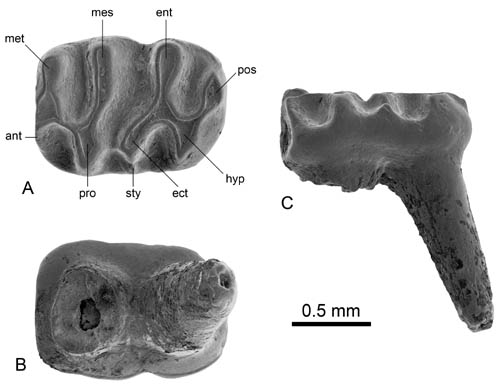Microtoid cricetids are widely considered to be the ancestral form of arvicoline rodents, a successful rodent group including voles, lemmings and muskrats. The earliest previously known microtoid cricetid is
Microtocricetus molassicus Fahlbusch and Mayr 1975 from the Late Miocene (MN9, about 10-11 million years ago) of Europe. Paleontologists from Institute of Vertebrate Paleontology and Paleoanthropology (IVPP), Chinese Academy of Sciences, described a new microtoid cricetid,
Primoprismus fejfari, from the Early Miocene deposits (roughly estimated at 18–17 million years ago) of the Junggar Basin in Xinjiang, northwest China. This new record is more than 6 million years earlier than the record of
M. molassicus, thus indicating a much deeper origin of microtoid rodents than previously assumed. The IVPP team reported online in the journal of
Acta Palaeontologica Polonica.
Since the 1980s, the IVPP team has been excavating and screen-washing samples from the Junggar Basin every year in order to collect mammalian fossils. The new species was unearthed from the new fossiliferous locality XJ200604, about 35 km northwest of Burqin city (47° 58.780' N - 86° 38.266' E), northwest of the previously known Early Miocene localities of the Junggar Basin. The rodent assemblage found in association with this specimen indicates a late Early Miocene age, roughly estimated at 18–17 million years ago.
Arvicolines have colonised all continents except Antarctica and Australia. The group is characterized by hypsodont and prismatic check teeth adapted to hard plant foods. The earliest undoubted arvicoline rodents appeared in northern Eurasia during the Early Pliocene, before rapidly dispersing into North America and southern Asia. It is widely accepted that arvicoline rodents are derived from cricetid ancestors (known as microtoid cricetids), with some late Miocene cricetids from Eurasia and North America showing arvicoline-style cheek teeth with various degrees of hypsodonty and prismatic morphology.
Morphological comparisons suggest that the new taxon is most closely related to
Microtocricetus molassicus, but it also presents a striking combination of primitive characters, including its relatively lower crown, smaller size, differentiated posterolophid and hypolophid, faint anterolophid, and the absence of an ectolophid, as well as the presence of a stylid on the labial border of the tooth. These primitive features suggest that
Primoprismus fejfari is much more archaic than all previously described microtoid cricetids, including
Microtocricetus molassicus.
However, the resemblance of
Microtocricetus and
Primoprismus suggests that these two taxa may belong to the same evolutionary lineage, with
Primoprismus probably representing a relatively early stage. Thus, it is possible that
Primoprismus fejfari falls very close to the common ancestor of all the Northern Hemisphere Late Miocene microtoid cricetids.
The gradual development of the hypsodont and prismatic tooth morphology of microtoid cricetids and arvicolines is usually interpreted as an adaptation to graminivorous feeding. “Arid conditions prevailing across the mid-latitude interior of Eurasia during the Early Miocene, enhanced by the combined effects of the Tibetan uplift and the gradual retreat of the Tethys Ocean, likely played a role in the appearance of grasslands which triggered the evolution of microtoid cricetids and, ultimately, the origin of arvicoline rodents”, said study coauthor Dr. WU Wenyu.
It has been suggested that the progressive development of a hypsodonty and prismatic tooth morphology among microtoid cricetids from the Late Miocene onward gave rise to true arvicoline rodents, and eventually resulted in the replacement of the former by the latter. “Recent molecular phylogenetic studies indicate that arvicolines, cricetines and sigmodontines form a monophyletic group, with the time of divergence of arvicolines and cricetines estimated to be either 15.5±0.6 or 18.8±1.0 million years ago, depending on the calibration point. The discovery of the microtoid cricetid from the Early Miocene of China reported here not only provides fossil evidence, but also could be used as a solid calibration point for further molecular clock analyses”, said first author Dr. Olivier Maridet of the IVPP.
This project was mainly supported by the Chinese Academy of Sciences (CAS) Young Scholar Project, the CAS 100-Talent Project, the CAS Fossil Excavation and Preparation Fund, the National Basic Research Program of China and the National Natural Science Foundation of China.

Fig.1. Type specimen, a left lower m2 of
Primoprismus fejfari gen. et sp. nov., IVPP V18128. A, occlusal view; B, ventral view; C, labial view. (Image by Olivier Maridet)
